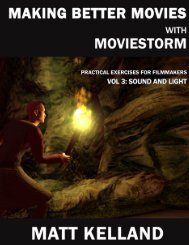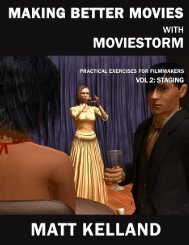Making Better Movies with Moviestorm Vol 1: Basic Camerawork
Making Better Movies with Moviestorm Vol 1: Basic Camerawork
Making Better Movies with Moviestorm Vol 1: Basic Camerawork
- No tags were found...
You also want an ePaper? Increase the reach of your titles
YUMPU automatically turns print PDFs into web optimized ePapers that Google loves.
EXERCISESHow to use this bookThe book is set out in a workbook format. Each exercise uses a standard structure:Technique: what you‟re going to focus onScenario: what type of scene works best for thisExercise: what you doReview: you critically analyze your work and see how the different versions compareFollow-up exercises: more things you can try to develop this techniqueTo get the best from this book, it’s important that you do two things.First, you must actually do the exercises.Reading them won‟t make you a better film-maker any more than reading about sports will make you an athlete.While developing <strong>Movies</strong>torm, I‟ve shot literally hundreds of hours of animated footage over the last few years.Looking back at the things I made early on, the improvement is obvious. Now, when I need to film something like asimple dialog or a walk, I‟m not wasting time. As I read the script, I instinctively know how I want to film it. Cameraangles and moves, cuts, staging, lighting, and even sound come alive in my head. These days I don‟t even make astoryboard; I simply go straight to <strong>Movies</strong>torm and quickly block out a rough version. That kind of fluency comesfrom having shot the same type of scenes over and over again.Second, you must be super-critical <strong>with</strong> yourself when it comes to the reviews.The aim isn‟t to complete all the exercises as fast as possible. It‟s to learn from them and find ways to improve. Inmost cases, there are no right and wrong ways to shoot these scenes (although there are accepted conventions it‟suseful to be familiar <strong>with</strong>). It‟s about trying out different things to see what happens. Even if they don‟t work, you‟velearned something. So don‟t just give yourself a pat on the back and move on. Be picky. Find the things you don‟tlike. Ask yourself if that scene could possibly be any better. At some point, you won‟t find anything more you can doto it. So move on, but come back to it later when you‟ve practiced some new techniques. I‟ll guarantee you‟ll seenew ways to film the scene.6




